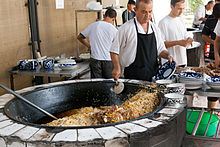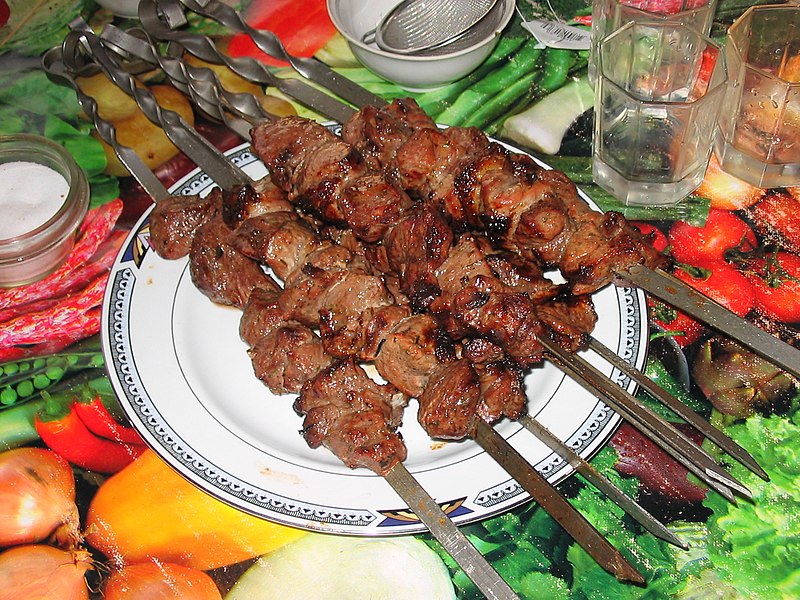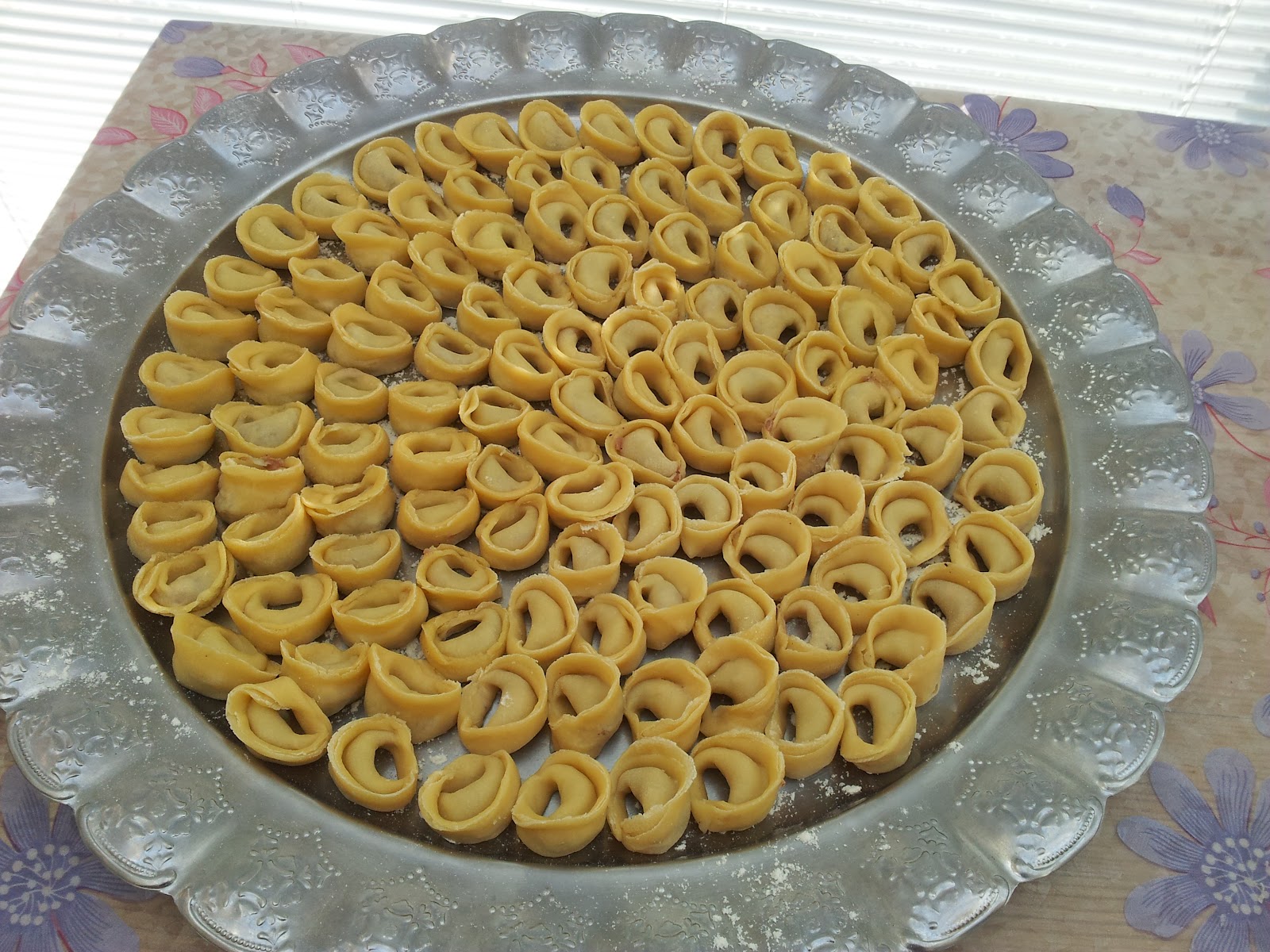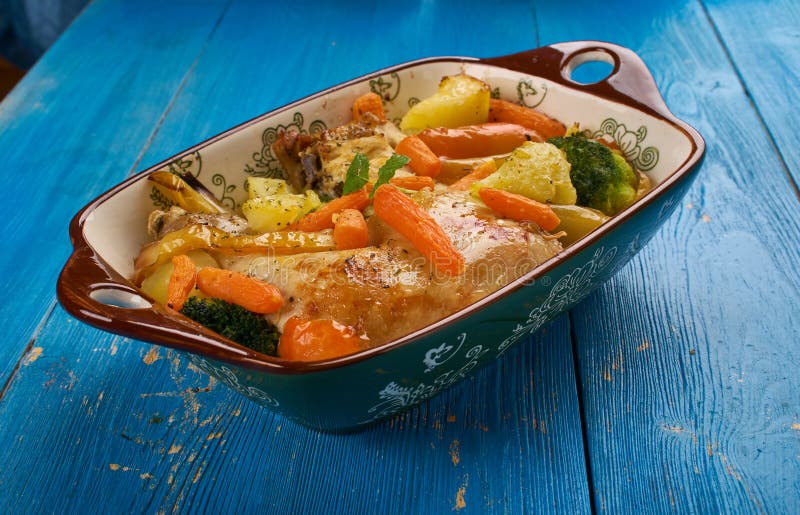List of notable Uzbekistani dishes and foods.
.Though the nation of Uzbekistan is relatively new, gaining independence only after the dissolution of the Soviet Union in 1991, their culture is one of the most ancient and rifined in Central Asia. One particulary distinctive and well-developed aspect of Uzbek culture is their cuisine. Unlike their nomadik neighbours, the Uzbeks have had a settled civilization for centuries. Between the deserts and mountains, in the oasis and fertile valleys, they cultivated grain and domesticated livestock. The resulting abundunce of produce allowed them to express their strong tradition of hospitality, which in turn enriched their cuisine.
The seasons, specifically winter and summer, greatly influence the composition of the basic menu. In the summer, fruits, vegetables, and nuts are ubiquitous. Fruits grow in abundance in Uzbekistan - grapes, melons, apricots, pears, apples, cherries, pomegranates, lemons, figs, dates. Vegetables are no less plentiful, including some lesser known species such as green redishes, yellow carrots, dozen of pumpkin and squash varieties, in addition to the usual eggplants, peppers, turnips, cucumbers and luscious tomatoes.
 |
| Uzbek manti |
The winter diet traditionally consists of dried fruits and vegetables and preserves. Hearty noodle or pasta-type dishes are also common chilly-weather fare.
In general, mutton is the preferred source of protein in the Uzbek diet. Fatty-failed sheep are prized not only for their meat and fat as a source of cookingoil, but for their wool as well. Beef and horsemeat are also consumed in substantial quantities. Camel and goat meat are less common.
The wide array of breads, leavened and unleavend, is a staple for the majority of the population. Flat bread, or nan, is usually baked in tandoor ovens, and served with tea, not to mention at every meal. Some varieties are prepared with onions or meat in the dough, others topped with sesame seeds or kalonji.
Central Asia has a reputation for the richness and delicacy of their fermented dairy products. The most predominant - katyk, or yoghurt made from sour milk, and suzma, strained clotted milk simmilar to cottage cheese, are eaten plain. in salads, or added to soups and main products, resulting in a unique and delicious flavor.
Palov, the Uzbek version of "pilaff", is the flagship of their cookery. It consists mainly of fried and boiled meat, onions, carrots and rice; with raisins, barberries, chickpeas, or fruit added for variation. Uzbek men pride themselves on their ability to prepare the most unique and sumptuous palov. The oshpaz, or master chief, often cooks palov over an open flame, sometimes serving up to 1000 people from a single couldron on holidays or occasions such as weddings. It certainly takes years of practice with no room for failure to prepare a dish, at times, containing up to 100 kilograms of rice.
Uzbek dishes are not notably hot and fiery, though certainly flavorful. Some of their principle spices are black cumin, red and black peppers, barberries, coriander, and sesame seeds. The more common herbs are cilantro (fresh coriander), dill, parsley, celeriac, and basil. Other seasonings include wine vinegar, liberally applied to salads and marinades, and fermented milk products.
There
is a great deal of grain farming in Uzbekistan, so breads and noodlesare of
importance, and Uzbek cuisine has been characterized as
"noodle-rich".Mutton is a popular variety of meat due to the
abundance of sheep in the country and it is a part of various Uzbek dishes.
Uzbekistan's
signature dish is palov a main course typically made with rice, pieces of meat,
grated carrots and onions. It is usually cooked in a kazan (or deghi) over an
open fire; chickpeas, raisins, barberries, or fruit may be added for variation.
Although often prepared at home for family and guests by the head of household
or the housewife,
Palov is made on special occasions by the oshpaz, or the osh
master chef, who cooks the national dish over an open flame, sometimes serving
up to 1,000 people from a single cauldron on holidays or occasions such as
weddings. Oshi nahor, or "morning plov", is served in the early
morning (between 6 and 9 am) to large gatherings of guests, typically as part
of an ongoing wedding celebration.
 |
| Plov (pilaf) in Tashkent |
Other
notable national dishes include: shurpa (shurva or shorva), a soup made of
large pieces of fatty meat (usually mutton) and fresh vegetables; norin and
lagman, noodle-based dishes that may be served as a soup or a main course;
manti (also called qasqoni), chuchvara, and somsa, stuffed pockets of dough
served as an appetizer or a main course; dimlama (a meat and vegetable stew)
and various kebabs, usually served as a main course
 |
| KOBOB |
Green
tea is the national hot beverage taken throughout the day;
teahouses(chaikhanas) are of cultural importance. The more usual black tea is
preferred in Tashkent. Both are typically taken without milk or sugar. Tea
always accompanies a meal, but it is also a drink of hospitality, automatically
offered green or black to every guest. Ayran, a chilled yogurt drink, is
popular in the summer, but does not replace hot tea.
The
use of alcohol is less widespread than in the west. Uzbekistan has 14 wineries,
the oldest and most famous being the Khovrenko Winery in Samarkand(est. 1927).
The Samarkand Winery produces a range of dessert wines from local grape
varieties: Gulyakandoz, Shirin, Aleatiko, and Kabernet likernoe (literally Cabernet
dessert wine in Russian). Uzbek wines have received international awards and
are exported to Russia and other countries in Central Asia.
The
choice of desserts in Uzbek cuisines are limited. A typical festive meal ends
with fruit or a compote of fresh or dried fruit, followed by nuts and halvah
with green tea.
| Plov, a popular dish in Uzbekistan, |
This
is a list of notable Uzbekistani dishes and foods.
Uzbek cuisine is the cuisine
of Uzbekistan. The cuisine is influenced by local agriculture such as grain
farming. Breads and noodles are a significant part of the cuisine, and Uzbek
cuisine has been characterized as "noodle-rich".Mutton is a popular
variety of meat due to the abundance of sheep in the country, and it used in
various Uzbek dishes. Ingredients used varies by season. For example, in the
winter, dried fruits and vegetables, noodles and preserves are prominent, while
in the summer vegetables, fruits (particularly melon) and nuts are more prominent.Bread
(nan, obi non) has a prominent role in Uzbek cuisine, and is influenced by
pre-Islamic traditions. In Uzbek culture, elders are typically served food
first, as a sign of respect toward them.
Uzbek
dishes and foods
- Chak-chak – unleavened dough fried in oil

- Chuchvara – a very small dumpling typical of Uzbek cuisine that is made of unleavened dough squares filled with meat.

- Chorba – one of various kinds of soup or stew found in national cuisinesacross the Balkans, Eastern Europe, Central Asia, and the Middle East.
- Dimlama – An Uzbek stew prepared with various combinations of meat, potatoes, onions, vegetables, and sometimes fruits. Meat (mutton or beef) and vegetables are cut into large pieces and placed in layers in a tightly sealed pot to simmer slowly in their own juices.

- Katyk – sour-milk yogurt
- Lagman – lamb and noodle soup
- Manti – also referred to as kaskoni,dumplings filled with ground meat and onion that are steamed.Typical meats used include mutton and beef. Manti are sometimes prepared in a specialized steamer designed to cook them, called a mantyshnitsa.
- Meats include mutton, beef, poultry, goat meat, camel meat and horse meat(such as horse meat sausage)
- Melons (qovun), such as watermelon, are a prominent part of Uzbek cuisine. Qovun means "melon", and may refer to a melon that has an elongated shape, which has been described as "exceptionally sweet and succulent." Melons are often served as a dessert.
- Naryn – a pasta dish made with fresh hand-rolled noodles and horse meat.
- Noodle-based dishe
- Fried nuts and almonds
- Obi Non – also called patyr and nan, is a bread that is a staple food in Uzbek cuisine. It is formed into large discs and cooked.Tradition holds that the bread is always placed flat side up (rather than upside-down), and never cut with a knife.Non is a significant part of Uzbek cuisine, and is influenced by pre-Islamic traditions. It is typically prepared in tandirovens. Styles of non can vary by region.
- Oshi toki – stuffed grape leaves
- Plov – a pilaf dish, it is a national dish of Uzbekistan. In Uzbek culture, it is customary for men to prepare the dish when it is served at feasts or celebrations.Per tradition, plov is typically eaten without the use of utensils, with the right hand, although sometimes a spoon is used.
Rice dishes
- Samsa – pastries filled with various meats and onion and cooked in a tandoor or standard oven.
- Shakarap – a salad prepared with tomato, onion, salt and pepper Some versions use a pumpkin filling during autumn.
- Kabob – meats (typically mutton or beef) grilled on a skewer or with a spit. Kabob are often sold at food stands and roadway stalls. Traditional kabob are prepared with meat only, omitting vegetables.
- Shurpa – a popular soup prepared with potatoes, vegetables and meat (typically mutton)
- Sumalak – sweet paste made entirely from germinated wheat (young wheatgrass)
- Suzma – clotted milk that is strained, forming curds
- Tirit – prepared to avoid wasting dry bread, it is prepared with the broth of offals and cutting dry bread and adding ground pepper and onion.
- Yogurt soup – yogurt soup cooked with a variety of herbs, rice and sometimes chickpeas.
SALADS
Clean and boil turnips and carrots. Cube turnips and carrots (about size of cheackpeas), dice onions, and chop the fresh dill. Soak the chickpeas overnight, boil until tender, and drain off water. You may use canned chichpeas instead. Combine vegetables in a large bowl, add sour cream, salt, dill and mix well.
Rinse brinza well in cold water. Grate and combine with minced garlic and dill. Add sour cream and butter and make an even mixture. Cut around the pepper steams and remove seeds and white flesh from the inside. Wash peppers and then blanch them by scalding in boiling water. Cool and fill with brinza mixture. Slice peppers crosswise in rings to serve.
Place thinly sliced onions in a bowl and wash it 2-3 times in hot water and add salt. Mix in the half of the seeds from the pomegranate with sliced onions. Crush and strain the other half of the seeds to make juice and add to onion mixture. Serve the salad decorated with onion cups filled with pomegranate seeds.
Cut tomatoes into thin round slices. Cut onions and pepper into very thin semi-circular slices. Combine all ingredients in a bowl, add salt, mix lightly. Arrange a hillock in salad bowl and top each serving with spring of greens.
Grate suzma well, put in a bowl, mix with chopped greens, green onions, salt and pepper.
Boil chicken and remove skin and bones from the meat. Cut chicken and peeled into thin strips. Cut tomatoes into very thin round slices, chop green onions and dill, and mince garlic. Set aside some cucumbers and tomatoes for garnish. Combine above ingredients in a large bowl, mix well, and season to taste. Arrange a hillock of salad in a serving bowl, top with mayonnaise, tomato and cucumber slices, and greens.
Peel green radishes, cut into thin strips and slice cheese in the same manner. mix them well with radish and salt.
Dice radish and boiled egg. Chop green onions, dill and fresh coriander, shred lettuce into very thin strips. Place ingredients in a bowl and combine with half a sour cream and spices. To serve, cover each portion with remaining sour cream and top with grated cheese.
Boil meet and cut into thin strips. Peel green radishes, cut into thin strips, soak in cold water for 10-15 minutes, and drain. Fry thinly sliced onions in oil. Combine meet, radish, fried onions, mayonnaise, salt and pepper and mix. To serve, make a hillock in salad bowl, garnish with quartered boiled eggs, strips of boiled meat, and chopped green onions and greens. Top each serving with a coating of the remaining mayonnaise.
In a large bowl, rub finely shredded cabbage with salt and work in well, forcing liquid from the shreds. Add chopped green onions and carrots cut into very thin strips. Mix in vegetable oil just before serving.

মন্তব্যসমূহ
একটি মন্তব্য পোস্ট করুন